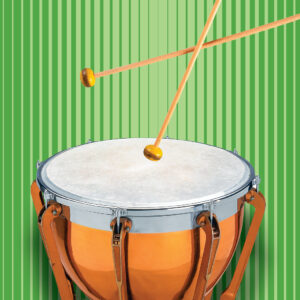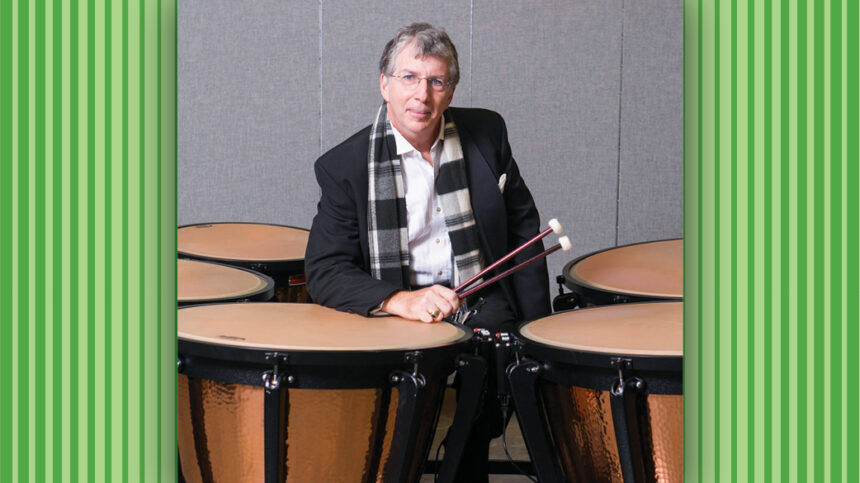Mississippi Symphony Orchestra Principal Timpanist Bud Berthold is the centerpiece of MSO’s February 24 “Striking Surprises” concert, 7:30 p.m. at St. James’ Episcopal Church, in Jackson.
Concerto for Six Timpani and Orchestra by Czech Jiri Družecky is one of those rare, classical-era compositions that puts the kettledrums front and center. Lively and upbeat, it focuses on the pitched drums’ melodic possibilities and offers a striking view of an instrument that is not often seen out front. Also on the program: Caroline Shaw’s Entr’acte, and Franz Joseph Haydn’s famous Symphony No. 94 in G Major, nicknamed the “Surprise Symphony.”
Bud came to the MSO as principal timpanist in the fall of 1981 and has held the position ever since. He originally hails from upstate New York and was fresh out of music school when openings at four orchestras lured him south. “It ended up being part of a little audition tour,” he said, stretching from Washington, D.C. to Houston, Texas. In the southern sweep, “MSO was the first one that hit.”
He and his wife, Anne Berthold, met while they were both attending the Manhattan School of Music in New York City. They were married a little over a year before the Mississippi move. Although they weren’t hired as a pair, once the orchestra made the principal percussion position a permanent one, her audition landed her that role.
In addition to his MSO duties as principal/solo timpanist, Berthold has taught percussion at various area high schools and colleges in the Jackson area, including Hinds Community College and Jackson State University. He is often hired to perform with several regional orchestras and is regularly featured on the drum set with the acclaimed Bluz Boys show band, as well as his own group, the Plus 1 Jazz Trio. Bud is currently on the music faculty of Belhaven University and continues to maintain a full studio of private percussion students.
“I’ve always been interested in the timpani as my ‘go-to’ in the percussion section, even as far back as junior high school,” Berthold said. Its classic orchestral presence and melodic character drew him in. It quickly became his concentration at the Manhattan School of Music, where he earned his Bachelor and Master of Music degrees in percussion under the instruction of Metropolitan Opera Orchestra Timpanist Fred D. Hinger.
 Družecky’s Concerto for Six Timpani was written in the late 1790s. It is one of the rare timpani concerto works from the classical period, a musical era largely dominated by Mozart, Haydn and Beethoven.
Družecky’s Concerto for Six Timpani was written in the late 1790s. It is one of the rare timpani concerto works from the classical period, a musical era largely dominated by Mozart, Haydn and Beethoven.
An oboist and pauken spieler himself, Družecky wrote a number of symphonies, a couple of operas and many solo concertos featuring a variety of instruments, including the timpani, where he himself would often conduct the orchestra from behind the kettledrums. “Pauken spieler,” Berthold said with a mischievous smile. “That’s German for timpani player.”
The piece stands out for its very soloistic timpani role. “It’s like I’m always in the forefront in terms of the melody and the form,” Berthold said. Throughout the piece he’s playing melody lines, doubled with the flute, clarinet or first violin — instruments more typically featured in solo passages.
“Since this timpani part is not merely accenting the fortes or punctuating the trumpet parts, you can tell it’s written by a composer who is a timpanist himself, or at least someone who understands the instrument pretty well. It’s not just bombastic timpani accents the whole way,” he said, with a knowing smile. “It sounds nice.
“One of my goals here is to emulate the sound that kettledrums had back in the day – it takes extra finesse and tone control to get that original period instrument sound. Clarity can also be a bit of a challenge. The timpani, especially more modern production instruments, ring through a lot and the drums can bleed over into each other, masking the articulation and the changes of pitch. It gets rather speedy in some places moving from drum to drum, so the more clarity I can get out of every stroke, the better. My choice of mallets on this piece will be a big help.”
The concert is titled “Striking Surprises.” What’s a surprising tidbit about the timpani? “Their early European pre-orchestral history,” Berthold offered. Along with trumpets, copper kettledrums were featured in military ceremonial events, often mounted on horseback. These crudely made early drums evolved together with trumpets to become the primary battle instruments of the cavalry. “Just imagine the frighteningly thunderous rumble that could be heard coming towards you from off in the distance!”

